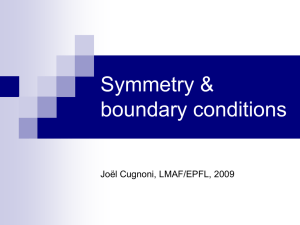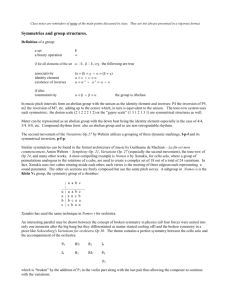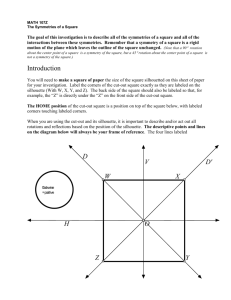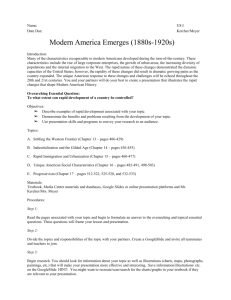Physical Symmetries, Overarching Symmetries - PhilSci
advertisement
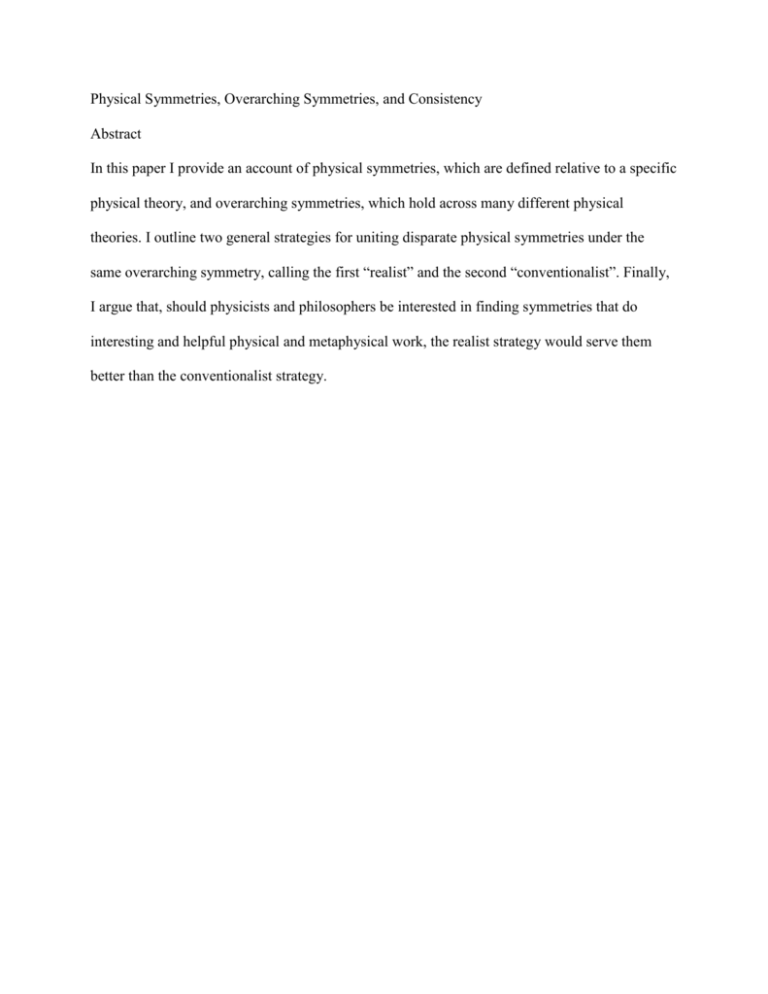
Physical Symmetries, Overarching Symmetries, and Consistency Abstract In this paper I provide an account of physical symmetries, which are defined relative to a specific physical theory, and overarching symmetries, which hold across many different physical theories. I outline two general strategies for uniting disparate physical symmetries under the same overarching symmetry, calling the first “realist” and the second “conventionalist”. Finally, I argue that, should physicists and philosophers be interested in finding symmetries that do interesting and helpful physical and metaphysical work, the realist strategy would serve them better than the conventionalist strategy. 1. Introduction Symmetries play an important role in our understanding of our best physical theories, giving us important information both about the world and the physical theories we posit to aptly represent the world. The project of this paper is to provide an account of two kinds of symmetries and justify a particular approach to investigating these symmetries. I divide symmetries into two classes, namely “physical” symmetries defined within the context of a specific physical theory and “overarching” symmetries defined across numerous physical theories. My first task in this paper is to provide an account of physical symmetries; however, most of this paper will focus on overarching symmetries and the relationship between overarching and physical symmetries. In particular, I will discuss “realism” and “conventionalism”, two different stances towards certain overarching symmetries, and provide several examples of how overarching symmetries may guide scientific inquiry. My central claim is that should we wish to use overarching symmetries as guides to what theories we should accept as the best successors to rejected theories, guides to the underlying metaphysical structure of the world, or indicators of inter-theoretic incompatibilities, we ought to take overarching symmetries to act “realist”-ically across physical theories. I thus argue that both realists and conventionalists have good reason to care about overarching symmetries that act consistently across different physical theories. 2. What are Physical Symmetries? Symmetries are of interest because they reveal meaningful operations under which basic structures are preserved. For instance, a starfish's radial symmetry tells us that the starfish's shape is preserved under rotations of certain intervals. And so in fundamental physics as well, what counts as a symmetry is a kind of operation that leaves a certain structure invariant1. There are essentially three features one must identify in order to understand any symmetry: the objects acted on by the symmetry, the way in which the symmetry transforms those objects, and the relevant structure(s) left invariant by the symmetry. Theses three features are invariably linked. Consider spacetime symmetries in special relativity, for instance. Such symmetries are maps from spacetime points to spacetime points that leave the Minkowski spacetime interval invariant. These symmetries are thus maps from points defined on a particular topological space (spacetime) to points on that same particular topological space that leave some particular feature of those points (the spacetime interval between points) invariant. In order to better understand theory-relative physical symmetries, then, we should investigate the sorts of topological spaces and invariant structures utilized by all physical theories. Physical theories, as I use the term for the purposes of this paper2, are essentially ordered tuples of the form <E,X,U,N>, where E is the set of equations utilized by a particular theory, X is the set of all independent variables appearing in the equations in E,3 U is the set of all dependent 1 Something like this general notion of symmetry can be found in, for instance, Belot (2011), Brading and Castellani (2007), Healey (2009), Ismael and van Fraassen (2003), and Roberts (2008). 2 I am not trying to give a full account of physical theories here; rather, what I refer to as a “physical theory" is a set of necessary features that I take all physical theories to have, all of which I will exploit shortly. 3 Over the course of this paper I will refer to X as both the set of independent variables and the space whose axes correspond to the independent variables in X. Context will determine which of the two I mean in each case, and I will similarly equivocate with my usage of U. variables appearing in the equations in E, and N is the “interpretation function” of that physical theory (more on that shortly). By dependent variables here I mean variables that can be represented as functions of the independent variables and whose derivatives in terms of these independent variables we take to be of physical interest. For instance, in Newtonian mechanics the variable representing the position of a ball rolling down an inclined plane can be represented as a function of the time that has passed since the ball was released, and so the variable “position” here is taken to be a dependent variable u and “time” is taken to be an independent variable t. There may be some conventional element in selecting which variables are dependent and which are independent for any particular physical theory; for instance, because the position u can be given in terms of the time t by u=f(t) , it is also the case that, for invertible f , t=f-1(u), so we may free to treat position or time here as the dependent variable. Alternatively, we may take the velocity of the ball, v=dx/dt, to be more fundamental than its inverse dt/dx and so take there to be a principled reason for treating t as the independent variable here instead of x. Typically, the variable that is easier for experimenters to control or manipulate is taken to be the independent variable, but this need not always be the case. My point here is only that it is up to the theory we are interested in to tell us what quantities to care about and whether to treat them as independent or dependent. The equations in E4 are conditions on functions of independent variables, dependent variables, and, in the case of differential equations, derivatives of the dependent variables with 4 This account follows the one given by Olver (1993). respect to the independent variables, that require these functions be zero5. So, for instance, in cases where there is only one independent variable x and one dependent variable u, an algebraic equation can be represented by the condition that the function e(x,u)=0. An equation can thus be characterized by the function it sets equal to zero, so I will take the elements of the set E to be the functions that the equations of the physical theory set equal to zero. Equations allow us to represent physical constraints rather than mere mathematical peculiarities because we take the variables appealed to by our physical theories to represent measurable features of the physical world, and so physical theories necessarily contain what I call an interpretation function N, which is a map from the variables appealed to by a physical theory and functions of these variables to measurement processes in the physical world that provide the values for these variables. Interpretations are necessary components of physical theories because two physical theories may utilize similar equations and variables to different ends. For instance, the heat equation: d(x,t,u)=∂u/∂t-∂2u/∂x2=0 could represent one-dimensional particle diffusion or the one-dimensional temperature change in, say, a metal bar. Since we measure position probability density functions (the “u” appealed to in the differential equation in the first case) and temperature (the “u” appealed to in the second 5 Though everything I say in this paper can be extended to an account that takes E to include differential as well as algebraic equations, due to length considerations, I will restrict my analysis in this paper to theories whose equations are all algebraic. case) differently, we can rely on N to distinguish these two different applications of the same differential equation6. Let's turn from my discussion of what physical theories are to the question of what topological space the objects of the physical theory live in. Algebraic equations, which are functions of independent and dependent variables only, can be represented by n-1-dimensional submanifolds of the n-dimensional space of dependent and independent variables X and U, which I will henceforth call the variable space XU. Each point in this space corresponds to a set of values for the variables in XU, and the theory differentiates between those sets of values that are physically possible according to a particular equation, which correspond to points in the equation's submanifold, from those sets of values which are not physically possible according to that equation. Few theories contain singleton sets of equations, and so we are typically interested not in each submanifold on its own but rather the intersections of the submanifolds corresponding to all of the equations in a physical theory’s E. It is these submanifolds that determine which sets of variable values the theory takes to be physically possible simpliciter and which values it does not. We can define a solution of an algebraic equation as a map from the 6 One may object here that physical theories do not all come equipped with particular interpretations; after all, many physical theories (most notably quantum mechanics) have numerous interpretational difficulties, and so stipulating that a physical theory like quantum mechanics comes with “an interpretation” seems strange. Note, however, that my technical usage of the “interpretation function” differs from what is typically meant by an interpretation of a physical theory: the job of my “interpretations” is only to tell us what measurement processes give us the values for the variables postulated by a physical theory, not to tell us anything about the underlying metaphysics of the world described by this theory. space of independent variables X to the space of dependent variables U such that, when this map is identified in the obvious way with a subset of the variable space XU, this subspace lies entirely within the submanifold determined by the equations. This notion of a solution extends naturally to characterize solutions of differential equations as well7. Following this definition of a solution, one can now posit a notion of symmetry that lines up nicely with the previously discussed notion of a spacetime symmetry. A symmetry8 of a physical theory T is a transformation that maps points in XU to other points in XU that keeps the solution structure the same. That is, a symmetry cannot map the points that lie entirely within the submanifold determined by T 's equations to points outside of the submanifold determined by T's equations. The objects transformed by a physical symmetry are points in a theory's variable space, and the structure preserved by a physical symmetry transformation is the solution structure of that space. The set of all transformations of a physical theory, along with a binary operation that defines the product of any two such transformations, constitutes a group. The search for physical symmetries is thus just the search for the group of symmetries that leaves the solution structure of a variable space invariant. I will forego some technical details here, but there are available mathematical methods that take advantage of the infinitesimal generators of groups that allow us to determine what the symmetry group of any particular function is9. So, in short, once we restrict our attention to physical theories that utilize 7 See Olver (1993) for the details. 8 I will restrict my talk of symmetries in this paper to point symmetries. Those interested in generalized symmetries should consult chapter 5 of Olver (1993). 9 Those who would like more detail on how this process works should consult Section 2.1 Olver (1993). only algebraic equations and define physical symmetries as I have, there are mathematical results that make the calculation of these symmetries (relatively) easy in many cases. 3. The Problem of Overarching Symmetries My account of physical symmetries in the last section explains what it is to be a symmetry of a physical theory, but there are plenty of contexts in which one may speak of a symmetry without referring to a particular physical theory. For instance, physicists may speak of translations, rotations, parity reversal, and the consequences of these symmetries without referring to any particular theory. Call such symmetries “overarching symmetries”. No sooner have we defined these symmetries, however, than we are faced with the following problem: what, exactly, is the relationship between theory-relative symmetries (physical symmetries) and theory-independent symmetries (overarching symmetries)? When should we count two physical symmetries as corresponding to the same overarching symmetry? Or, put more formally: suppose that some theory T1=<E1,X1,U1,N1> with n independent variables and m dependent variables is invariant under the point symmetry transformation S1, which operates on a point p=(x11,…,xn1,u11,...,um1) , where xi1X1 and ui1U1, as follows: S1(p)=(f1(x11,…,xn1,u11,…,um1),…,fn+m(x11,…,xn1,u11,…,um1)) for some functions f1,…,fn+m. Now, suppose there is another theory T2=<E2,X2,U2,N2> with j independent variables and k dependent variables which is invariant under the point symmetry transformation S2, which operates on a point q=(x12,…,xj2,u12,…,uk2) , where xi2X2 and ui2U2, as follows: S2(q)=(h1(x12,…,xj2,u12,…,uk2),…,hj+k(x12,…,xj2,u12,…,uk2)) for some functions h1,…,hj+k. Under what conditions can we say that T1 and T2 are invariant under the same overarching symmetry transformation?10. Another complicating feature is the fact that variables that appear in two different physical theories may refer to the same feature of the physical world or may be calculated by exactly the same methods. For instance, we may refer to the length of a metal bar in the context of both classical thermodynamics and special relativity. In both cases the length of the bar can be calculated by the same measurements because the physical quantity, length, is the same. So, we may be especially worried about how to pick out the symmetry corresponding to S2 in the formalism above when, for some a in X1U1 and b in X2U2, N1(a)=N2(b) or N1(f(a))=N2(f(b)) for some f. Call any two such variables empirically identical. Though I cannot address all of the criteria one could lay down as good candidates for determining which physical symmetries fall under the same overarching symmetry, I can outline two reasonable positions regarding these criteria. The difference between these two positions rests on how strong a criterion one utilizes for determining when physical symmetries are related to one another by an overarching symmetry and when they are not. For our purposes, I propose 10 I will leave aside for now the question of whether there is any natural property à la Lewis (1983) picked out by all overarching symmetries. My account allows that the question “Is X really an overarching symmetry?” may or may not be substantive; the real project for those investigating overarching symmetries, I take it, isn't to figure out what overarching symmetries correspond to the real overarching symmetries in the world (if there are any) but rather to lay down a useful criterion for what constitutes a particular overarching symmetry and argue why this criterion is the most useful one. (but will not defend at length) a criterion based on the following definition, though any equally strong criterion should do for the points I will make in the rest of the paper: (Consistency): Take T1=<E1,X1,U1,N1> to be a physical theory invariant under the symmetry transformation S1, which maps each coordinate vi1in X1U1 to fi1(v11, v21,…), and take T2=<E2,X2,U2,N2> to be a physical theory invariant under the symmetry transformation S2, which maps each coordinate vj2 in X2U2 to fj2(v12,v22,…). There are two sets of variables AX1U1 and BX2U2 such that vi1X1U1, if vj2X2U2 such that vi1 and vj2are empirically identical, then vi1A, and vj2X2U2, if vi1X1U1 such that vj2and vi1are empirically identical, then vj2B. S1 and S2 are consistent if and only if, vi1A and vj2B for non-empty A and B, the empirical identity of vi1 and vj2 implies fi1=fj2 for some fixed values of all the variables vn1A and vm2B for which fn1 and fm2 are not constant functions. Despite its formal complexity, Consistency is intuitively easy to understand. Essentially, two physical symmetries are consistent only if both symmetries treat the “same variables” in the “same way”. By “same variables” here I mean variables that are empirically identical, and by treating these variables in the “same way”, I mean that, S1 and S2 use the same functions to transform empirically identical variables, ignoring changes involving the empirically nonidentical variables. To give an example: suppose that one theory has a symmetry S1 that transforms points in its variable space as follows: S1(x,y,z)=(z(x+y),y,z) , and suppose that another theory has a symmetry S2 that transforms its points as follows: S2(x,y,w)=(x+y+w,y,w), where I have used the same variable name to denote variables in different theories that are empirically identical to one another. S1 and S2, according to my definition, are consistent since S1(x,y,1)=(x+y,y,1) and S2(x,y,0)=(x+y,y,0); however, S3, which acts as follows: S3(x,y,w)=(x+y,x+y,w), is not consistent with S1 since y!x+y. We can now define at least two positions on overarching symmetries, the first of which requires that all physical symmetries associated with some overarching symmetry be consistent11. I will call such a position “realist”. The second position denies consistency as a constraint on overarching symmetries in favor of some weaker criterion. I will call such a position “conventionalist”12. The realist holds, basically, that an overarching symmetry unites consistent physical symmetries across physical theories. For instance, if T1 has a coordinate x that refers to time and T2 has a coordinate t that refers to time, then if T1 is invariant under “time translation” via a physical symmetry that takes x to x+a, then T2 can only be invariant under the same overarching symmetry of “time translation” if it is invariant under a transformation that takes t to t+a (modulo some variables that may appear in one theory but not the other). More importantly, if two theories refer to some common set of parameters (e.g. time, position, and momentum), then the two theories are invariant under the same overarching symmetry, according to the realist, only if there is some symmetry transformation defined on the first theory that treats these parameters the same way that some symmetry transformation defined on the second theory does. 11 Or as I said before, some equally strong or stronger criterion for overarching symmetry-hood. For the rest of the paper, interpret all appeals to consistency as appeals to “some criterion at least as a strong as consistency”. 12 Note that, as defined, realism and conventionalism are relative to the particular overarching symmetry under consideration. There is no reason to disallow, say, simultaneous realism about time reversal and conventionalism about gauge transformations. Conventionalists, on the other hand, embrace some weaker constraint, making it easier for two different symmetries to be identified with the same overarching symmetry. For instance, in the previous example, one sort of conventionalist could argue that, despite the fact that T1 is only invariant under a symmetry that takes x to x+a and the T2 is only invariant under a symmetry that takes t to –t+a, T1 and T2 may still be invariant under the same overarching symmetry because both symmetries satisfy the weaker criterion of transforming empirically identical variables by some procedure that adds an arbitrary constant. Some conventionalist criteria may come quite close to realism’s. For instance, the conventionalist may adopt a criterion that overarching symmetries link up physical symmetries that act consistently on one particular variable. Regardless of the specific criterion, however, what separates realists and conventionalists is that conventionalists allow a strictly larger set of physical symmetries to qualify as potential instances of a particular overarching symmetry than realists allow. The difference between realism and conventionalism clearly becomes salient when trying to determine certain important features of physical theories. We may be interested, as many philosophers of time and philosophers of physics have been, in the question of whether or not the fundamental laws of physics are invariant under time reversal. Realists trying to answer this question will look at each fundamental physical theory to determine whether or not its time reversal symmetry (if it exists) can be consistently unified with the time reversal symmetries of the other fundamental physical theories. Conventionalists, meanwhile, will likewise examine each physical theory to be sure that there is some point symmetry suitably called “time reversal” (under some weaker standard) under which it is invariant, and should they find at least one transformation for all fundamental physical theories, they will be happy to agree that the fundamental laws of physics are invariant under time reversal. Henceforth I will refer to the general strategy of looking for a consistent overarching symmetry as the realist strategy and the strategy of searching for physical symmetries that satisfy some weaker criterion on overarching symmetries as the conventionalist strategy, though I should point out that conventionalists can adopt the realist strategy too. In the remainder of this paper, I will argue that the realist strategy ought to be the first one that philosophers and physicists pursue when investigating overarching symmetries by suggesting some philosophical work that consistent overarching symmetries can do for us that inconsistent overarching symmetries cannot. 4. Overarching Symmetries, Theory Change, and Ontology Overarching symmetries help us to determine which new theories should replace older, falsified theories. Typically, when an earlier theory has been rejected and physicists are searching for a new theory to replace it, physicists don't just start from scratch. They assume that many of the features of the old theory were, in fact, correct, assuming the theory in question had a history of empirical successes. The old theory must have gotten something right to be successful, so since new theories should be strictly better than the theories they replace, we need a way to identify those successful features of our old theories and carry those features over into our new theories. Successful features of older theories can thus constrain what good candidates for these theories' replacements should look like. Symmetries are typically features of the world that carry over from older theories to newer theories. Imagine, for instance, a fictitious history of physics in which Newtonian mechanics is rejected after observing the behavior of particles traveling close to the speed of light. Under such circumstances, we would be justified in searching for a successor to Newtonian mechanics like special relativity that isn't invariant under Galilean boosts; however, we have no reason to reject the symmetries of spatial and temporal translation under which Newtonian mechanics was invariant. So even if our evidence gives us good reason to reject important features (including symmetries) of a previous theory, that same evidence may still lead us to uphold some symmetries of the old theory. Realist overarching symmetries are the most likely to yield useful results when trying to carry symmetries over from failed theories to their successors. Realist symmetries guarantee that the new theory’s overarching symmetries differ as little from their predecessors as possible, as least as far as symmetries are concerned. This is not the case with conventionalist symmetries. Take theory A, which is invariant under the symmetry S1(x,y,z)=(z(x+y),y,z) and which is to be replaced by either theory B, which is invariant under the symmetry S2(x,y,w)=(x+y,y,w), or theory C, which is invariant under the symmetry S3(x,y,w)=(x+y,x+y,w). The realist singles out B as the best successor to A since they share an overarching symmetry while the conventionalist may take both B and C to be equally good successors to A since they share an overarching symmetry even though intuitively S1 seems much closer to S2 than S3. If we want symmetries to help us choose useful successor theories, then it seems best to adopt the realist strategy. Overarching symmetries may also serve as guides to extracting metaphysics from our best available theories. In some cases, especially when the symmetries in question are spacetime symmetries, the failure of a particular theory to be invariant under an overarching symmetry provides us with a good reason to think that there is some special structure in the world whose existence keeps the theory in question from being invariant under that overarching symmetry. Those who adopt Earman’s (1989) symmetry principles, for instance, maybe take the asymmetries of dynamical laws to suggest geometrical features of spacetime. But symmetries also help to pare down metaphysical commitments; for instance, according to a view I will call physical equivalence (PE) embraced by Baker (2010), Ismael and van Fraassen (2003), and North (2009), symmetries act as a guide to surplus structure. PE holds that the notational differences between two solutions related by a symmetry do not correspond to deep physical differences between two physical states while a notational difference between two solutions which are not related by a symmetry does. Leibniz shift arguments provide an example of PE in action: because our universe is spatial translation invariant, we have good reason to believe that there are no physical structures like, say, absolute space that privilege one position in space over another. Given these examples, one may feel compelled to adopt either the realist or conventionalist strategy depending on one’s projects in metaphysics. If one prefers metaphysical desert landscapes, one may be tempted to adopt both PE and the conventionalist strategy since such an approach will find more solutions to be essentially identical to one another, thus eliminating from our fundamental metaphysics interesting properties that could distinguish one solution from another13. Those more interested in using PE to find asymmetries and use them to posit metaphysical structures, on the other hand, may be more interested in the realist strategy and its stricter criterion on overarching symmetries. At the moment, metaphysical considerations alone don’t seem to privilege either account over the other except insofar as one finds one of these projects more interesting than the other. 13 It is worth noting, though, that some conventionalist strategies may be so permissive as to undermine the motivation for PE in the first place and may not provide a rich enough metaphysical background to draw the kinds of useful distinctions we want to draw. But the relationship between symmetries and metaphysics does give us another reason to think that, no matter our projects in metaphysics, we should focus our attention on those symmetries that transform the same objects and relations consistently across physical theories. If we do think that symmetries can help us determine the ontological commitments of our physical theories, and if we think that all of the physical theories are, in fact, representations of the same objective world, then the ontologies identified by different physical theories should line up nicely with one another. For instance, if one theory is committed to the existence of a preferred inertial reference frame (as some formulations of quantum mechanics are) and another theory is committed to the physical equivalence of all inertial reference frames (in the way that special relativity is if we assert something like PE for velocity boosts), we have good reason to think that at least one of these theories is wrong since at most one can accurately represent the way the world actually is. If we want a consistent picture of what the world is like from these theories, and if we think that symmetries can tell us something about the ontological commitments of our physical theories, then even the conventionalist needs to accept the fact that consistent overarching symmetries will be more useful than inconsistent overarching symmetries. Consider the following case: take the two theories T1 and T2, both of which are the best currently available physical theories with empirically identical variable x, which is position. T1 is invariant only under the symmetry S1(x,y)=(-x,y) while T2 is invariant only under S2(x,z)=(-x,1/z). S1 and S2 are consistent, and so they fall under the same realist overarching symmetry. This realist overarching symmetry (let’s call it “parity reversal” for short) suggests that there is no fundamental structure that distinguishes between “left” and “right” in the universe since for every solution to the equations in T1 or T2 there is a “parity reversed counterpart” related to this solution by S1 or S2 respectively that is also a solution to the equations in T1 or T2. In short, there is no dynamical structure that treats objects on the “left” differently from objects on the “right”, and so, since all of our best physical theories are invariant under this parity reversal symmetry, we have good reason to think that there is no fundamental feature of our universe that distinguishes between left and right. Since realists utilize a stricter overarching symmetry criterion than conventionalists, the conventionalists agree with the realists about this example of parity reversal. If T2 were instead only under S3(x,z)=(2x,z), the realist would not recognize any overarching symmetry uniting S1 and S3, so she would claim that there are important inconsistencies between T1 and T2 that warrant further investigation. Such physical symmetries reveal that one of these two theories must be getting something about the world wrong, and one needs a condition on overarching symmetries like consistency that is sensitive to symmetry transformations of empirically identical variables in other physical theories for this interesting result. Conventionalists, however, may argue that there is some overarching symmetry that unites S1 and S3, perhaps on the grounds that both physical symmetries transform the position coordinate by a constant integer scaling factor while leaving the other coordinates unchanged, but it is unclear to me what invariance under such an overarching symmetry tells us about the world described by T1 and T2. We can no longer say, as we did in the case of parity reversal, that the world doesn’t distinguish between left and right since it is not the case that solutions to the equations of T2 have parity-reversed counterparts that are also solutions to the equations of T2. Perhaps the conventionalist takes the interesting metaphysical consequence of invariance under this symmetry to be that there is no metaphysical structure in the world that distinguishes between either “left” solutions and “right” solutions or solutions and their “position-doubled” counterparts, but such a weird disjunctive structure seems metaphysically worthless. This toy example shows that realist overarching symmetries serve as better guides to both physical and metaphysical projects than do conventionalist overarching symmetries, so one could say that, despite her conventionalism, if a conventionalist has the inclination to draw a useful connection between physical symmetries and ontology, she should be prepared to act as a realist in many situations. 5. Conclusion Given my approach to physical symmetries, we are left with two ways to proceed: when searching for overarching symmetries, we can follow the realist and search for consistent overarching symmetries, or we can follow the conventionalist and also search for inconsistent overarching symmetries that satisfy some other criterion. As I have argued, conducting the realist's narrow search is more likely to yield the kinds of results that both scientists and philosophers are likely to find pragmatically useful, and as such it may be in the best interest of even the conventionalist to carry out the realist's narrow search first before conducting the broader search. References Baker, David. 2010. “Symmetry and the Metaphysics of Physics”. Philosophy Compass 5 (12): 1157-1166. Belot, Gordon. 2011 . “Symmetry and equivalence”. In R. Batterman, editor, The Oxford Handbook of Philosophy of Physics, page Forthcoming. Oxford University Press. URL http://philsci-archive.pitt.edu/8446/. Brading, Katherine and Elena Castellani. 2007. “Symmetry in classical physics. In J. Butterfield and J. Earman, editors, Handbook of the Philosophy of Physics, pages 1331– 1367. NorthHolland. Earman, John. 1989. World Enough and Space-Time: Absolute versus Relational Theories of Space and Time. MIT Press. Healey, Richard. 2009. “Perfect symmetries”. The British Journal for the Philosophy of Science 60: 697–720. Ismael, Jenann and Bas van Fraassen. “Symmetry as a guide to superfluous theoretical structure”. In K. Brading and E. Castellani, editors, Symmetries in Physics: Philosophical Reflections, pages 371–392. Cambridge University Press, 2003. Lewis, David. 1983. “New work for a theory of universals”. Australasian Journal of Philosophy 61: 343–377. North, Jill. 2009. “The ‘structure’ of physics: A case study”. Journal of Philosophy 106: 57–88. Olver, Peter. 1993. Applications of Lie groups to differential equations, 2nd ed. Springer Verlag. Roberts, John. 2008. “A puzzle about laws, symmetries, and measurability”. The British Journal for the Philosophy of Science 59:143–168.
